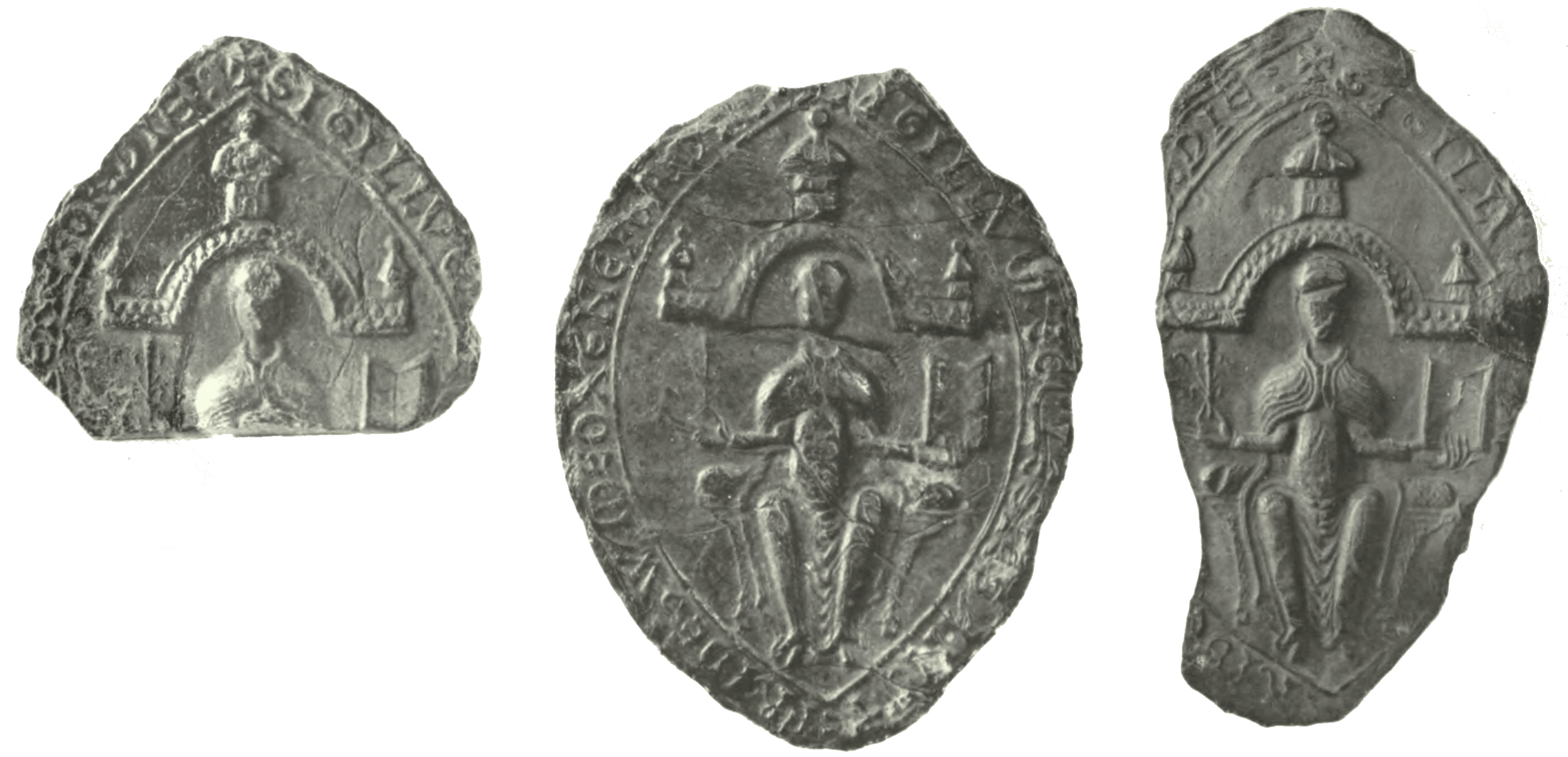Oval seal, 1/2",
Brit.Lib. BM Add.5614, BM Add.22869
Merton Coll. Ox.: c.iv
Soc.Ant.:
1241
John Cherry wrote that 'the seal of Merton Priory (1241), considered the finest English medieval seal, had the Virgin and child on one side
with St. Augustine of Hippo on the other.'
H. Kingsford said 'The obverse of this is to my thinking the finest seal ever cut.' Here it is:
The Blessed Virgin Mary (BVM) sits crowned and enthroned with the infant Christ on her knee, and a ‘virga,’ a rod or stick, in her right hand. The virga is a pun on ‘virgo’ (virgin’), probably also a reference to the ‘virga Jesse’ (the family tree of Jesse), and perhaps also a nod to erudition: you use your virga to inscribe your wax tablet. In the lovely Age of Chivalry catalogue, Sandy Heslop mistakes this as a mirror, which is a result of the juxtaposition of the virga and the dexter panel. That would make the scene asymmetric, which is a no-no!
The BVM’s throne and canopy are elegant, up-to-date gothic architecture. The corbel holding up her throne seems to be an flowingly floriated fleur-de-lys, which by the 11th century had become associated with Mary, the ‘lilium inter spinas.’ The canopy is unlikely to be a real building, but rather the artist’s flight of fancy. The background is diapered (divided into lozenges or diamonds), with quatrefoils in each. Heales suggests these are roses, which again are symbols of Mary (‘rosa sine spinas’); roses also begin and end the inscription around the seal. Out of two roundels (or ovals) peep two canons.
*SIGILL’ : ECCLESIE : SANCTE : MARIE : DE : MERITONA
The seal of the church of St Mary of Merton
On the reverse bears St. Augustine standing on a small, but decorated, corbel, with another ornate gothic church canopy, under which is an arch supported by filigree shafts. He is in full episcopal gear, with mitre and crozier, his right-hand blessing us. The same diaper work in the background, and the legend:
+MUNDI : LUCERNA : NOS : AUGUSTINE : GUBERNA
Light of the world, our rudder, Augustine
Heales notes that ‘the rim of this fine seal also bears the following legend:’
AUGUSTINE : PATER : QUOS : INSTRUIS : IN : MERITON : HIS : CRISTI : MATER : TUTRIX : EST : ATQUE : PATRONA
Father Augustine, you instruct those in Merton to whom the Mother of Christ is guardian and patroness
Heales also writes that ‘The finest impression is that attached to the original grant by the Priory of the manor and advowson of Maldon to Sir Walter de Merton in 1265, now preserved amongst the records of Merton College, Oxford. Good impressions also exist amongst the charters in the British Museum. The use of the reverse of this seal seems to have been discontinued or the matrix may have been lost. A charter dated 1407 [BM Add.5614] is sealed with the obverse, but the revers is simply stamped with the letters S and M…
Of the seals of the Priors three examples are known. The earliest is that of Prior Eustace attached to a deed dated 1252 [Merton Coll c.iv]. The seal is imperfect, the upper half alone remaining; it is a pointed oval, the centre design being a hand holding a cross, the arms of which terminate in fleur-de-lys with a crescent and an estoile below. Only a few letters of the legend remain:
E…… RITONE
Another affixed to a deed dated 1349 [BM Add.22869] has a somewhat similar design with a few illegible letters placed bendwise over the hand. The third example is a cast in the BM said to have been taken from an impression in the Records Office [now the National Archives], but no reference can now be obtained to the original. The seal is imperfect: the central device is a hand supporting a branch whereon are two birds, and the legend reads:
…CITIUS BEATE MON’E Z MAT…’
Henry III's first seal has similarly intricate gothic architecture, but his first seal has real similarities in folds and general treatment. This was made by
Walter de Ripa, who is assumed to have died in the late 1220s, as 'no later work by him has yet been discovered' (Heslop). Merton's seal is from 20 years later. It's possible Walter was still going. Kingsford, in his
classic article on seal engravers, attributes it to a later royal engraver, Edward of Westminster, but only because he was employed by the king - in fact, earlier, Kingsford expresses doubt as to Edward's being a seal-fabricator anyway!
Kingsford points out the similarity with the seal of Bruton Priory, Somerset.
_________________________________
Oval
Late 12th century.
Merton had a seal before that, photographed and recorded by
Heales, and dated by him to 1197, from an entry in the Annals of Merton,
Corpus Christi MS059 fol.168v. (This replaced an even earlier one.) This seal was in his own collection, and I have yet to find out what happened to it. Again, the BVM is seated with the Christ child (who looks as though he's about to leap off her lap). It's a dynamic image. The legend is:
...SC...MARIE : DE : MER..., and reverse CELI REGINA MARIA MVNDI DNA and + MATER : MISERICORDIE + PATRONA MERITONIE.

A letter in support of the canonisation of Edmund of Abingdon from February 1242 that is now in the Yonne archives has the obverse of the 1241 seal, but as its reverse, the older counterseal, with a
perfect impression.
 This was a small nunnery near Totnes. Founded in 1238, this was a poor and isolated community. The seal probably dates from then.
This was a small nunnery near Totnes. Founded in 1238, this was a poor and isolated community. The seal probably dates from then.














